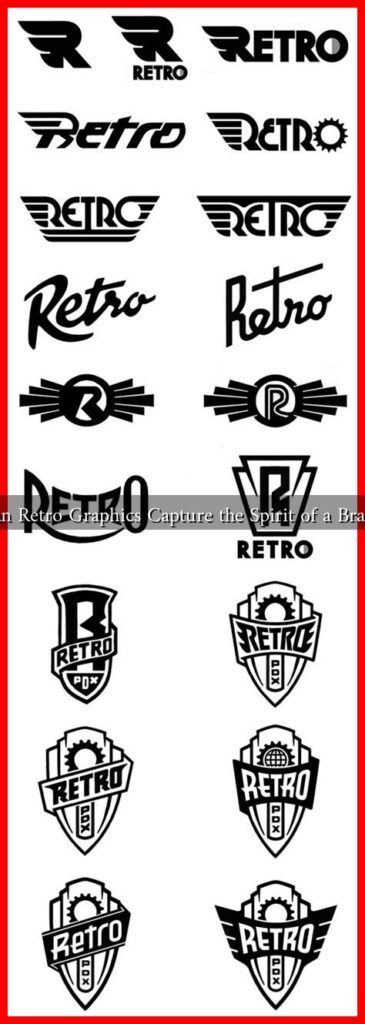-
Table of Contents
Can Retro Graphics Capture the Spirit of a Brand?
In an era dominated by sleek designs and high-definition visuals, the resurgence of retro graphics in branding has sparked a fascinating conversation. Retro graphics, characterized by their nostalgic appeal and vintage aesthetics, have the potential to evoke emotions and memories that resonate deeply with consumers. But can these graphics truly capture the spirit of a brand? This article explores the intersection of retro design and brand identity, examining how nostalgia can be a powerful tool in modern marketing.
The Power of Nostalgia in Branding
Nostalgia is a potent emotional trigger that can influence consumer behavior. According to a study published in the journal *Psychological Science*, nostalgic feelings can enhance feelings of social connectedness and increase positive attitudes toward brands. This emotional connection can lead to increased brand loyalty and consumer engagement.
- Emotional Resonance: Retro graphics can evoke memories of simpler times, creating a sense of comfort and familiarity.
- Brand Differentiation: In a crowded marketplace, retro designs can help brands stand out by appealing to consumers’ emotions.
- Targeting Specific Demographics: Brands can leverage retro aesthetics to connect with specific age groups who have a fondness for the past.
Case Studies: Brands Embracing Retro Graphics
Several brands have successfully integrated retro graphics into their branding strategies, demonstrating the effectiveness of this approach.
Coca-Cola
Coca-Cola has long utilized retro graphics in its marketing campaigns. The brand’s vintage advertisements, featuring classic logos and designs, evoke a sense of nostalgia that resonates with consumers. For instance, the “Share a Coke” campaign incorporated retro-style labels that harkened back to the brand’s origins, successfully appealing to both older and younger generations.
Levi’s
Levi’s has also embraced retro aesthetics, particularly in its marketing of vintage denim styles. The brand’s “Vintage Clothing” line features designs that replicate the look and feel of jeans from the 1960s and 1970s. This strategy not only appeals to consumers’ nostalgia but also reinforces Levi’s identity as a timeless and authentic brand.
The Role of Social Media in Retro Branding
Social media platforms have become essential tools for brands looking to leverage retro graphics. The visual nature of platforms like Instagram and Pinterest allows brands to showcase their nostalgic designs effectively. Additionally, user-generated content featuring retro graphics can amplify a brand’s reach and engagement.
- Hashtags and Trends: Brands can create specific hashtags to encourage consumers to share their retro-themed content, fostering a sense of community.
- Influencer Collaborations: Partnering with influencers who resonate with retro aesthetics can help brands reach a wider audience.
- Engaging Content: Brands can create engaging posts that highlight the history and evolution of their products, further deepening the connection with consumers.
Challenges of Using Retro Graphics
While retro graphics can be a powerful branding tool, they are not without challenges. Brands must navigate the fine line between nostalgia and relevance. Over-reliance on retro aesthetics can lead to perceptions of being outdated or out of touch with contemporary trends.
- Balancing Modernity and Nostalgia: Brands must ensure that their retro designs do not alienate younger consumers who may not relate to the nostalgia.
- Authenticity: Brands should strive for authenticity in their retro designs to avoid appearing disingenuous or opportunistic.
- Market Saturation: As more brands adopt retro graphics, standing out becomes increasingly challenging.
Conclusion: Capturing the Spirit of a Brand
In conclusion, retro graphics can indeed capture the spirit of a brand, provided they are used thoughtfully and strategically. By tapping into the emotional resonance of nostalgia, brands can create meaningful connections with consumers, differentiate themselves in a crowded market, and foster loyalty. However, it is crucial for brands to balance nostalgia with modern relevance to ensure they remain appealing to all demographics. As the landscape of branding continues to evolve, the thoughtful integration of retro graphics may well be a key strategy for brands looking to connect with their audiences on a deeper level.
For more insights on branding and marketing strategies, consider exploring resources like Harvard Business Review.


